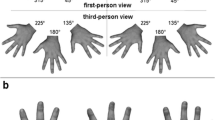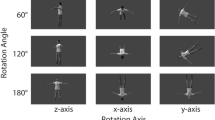Abstract
Previous data suggest that the right temporo-parietal junction (rTPJ) may have a specific role in abnormal body perception (ABP), including out-of-body experience. We tested this hypothesis with inhibitory (1 Hz) and excitatory (15 Hz) repetitive transcranial magnetic stimulation (rTMS) of the rTPJ and a control site (CS, 5 cm posterior to the rTPJ along the lateral sulcus direction in Brodmann area 19R) in 35 healthy adults. ABP frequency was higher with 1 Hz than with 15 Hz rTMS but unaffected by the rTMS site (rTPJ/CS). Response to an own-body transformation task were delayed with 1 Hz compared to 15 Hz rTMS but also unaffected by rTMS site. ABP from rTMS at both sites induced electroencephalographic power decrease in all frequencies at left anterior and central cortical sites. Our data suggest that inhibitory rTMS can lead to ABP. However, the rTPJ may not play a specific role in this process.






Similar content being viewed by others
Notes
Fifteen participants who reported no cognitive, neurological, or psychological deficits and did not participate in the main study were included. All participants received eight euros per hour for their participation and provided written informed consent to the study, which was conducted in accordance with the guidelines of the Declaration of Helsinki, and approved by the Ethics Committee of the University Hospital, University of Tübingen. Fifteen Hz rTMS was applied over CP6 (according to the 10-20 EEG System) for 2 s with an inter-train interval of 10 s. Participants were instructed to press one of two buttons to indicate whether they experienced or not an ABP, which was defined as “any unusual body sensation except those on the scalp”. Responses were given with the right hand with the index or the middle finger. Assignment of the response type (presence or absence of ABP) to the finger (index or middle finger) was counterbalanced across participants.
Despite applying rTMS trains for 40 min over CP6 and testing the locations 1–2 cm surrounding CP6, none of the participants reported an ABP.
An analysis of relative spectral power (with power in the delta band as reference) has also been done. Since the results were similar to the results found with absolute power, we report only the absolute power data. We also performed absolute and relative power analyses on restricted EEG epochs including only the 3 s preceding the EEG markers of the participant’s response. Again, results were similar. Thus, we report only the results over the whole epochs, that is using a time-window of 8 s with 3 s before and 5 s after the markers.
The main aim of the study was to test the hypothesis that stimulation of the rTPJ results in ABP. Due to the limited spatial resolution of the rTMS, we did not and could not test any hypothesis about the role of different rTPJ subregions in body perception.
References
Agresti A, Booth JG, Hobart JP, Caffo B (2000) Random effects modeling of categorical response data. Sociol Methodol 30:27–80
Arzy S, Thut G, Mohr C, Michel CM, Blanke O (2006) Neural basis of embodiment: distinct contributions of temporoparietal junction and extrastriate body area. J Neurosci 26:8074–8081
Bartko JJ (1976) On various intraclass correlation reliability coefficients. Psychol Bull 83:762–765
Berlyne DE, McDonnell P (1965) Effects of stimulus complexity and incongruity on duration of EEG desynchronization. Electroencephalogr Clin Neurophysiol 18:156–161
Blanke O, Castillo V (2007) Clinical neuroimaging in epileptic patients with autoscopic hallucinations and out-of-body experiences. Epileptologie 24:90–95
Blanke O, Ortigue S, Landis T, Seeck M (2002) Stimulating illusory own-body perceptions. Nature 419:269–270
Blanke O, Landis T, Spinelli L, Seeck M (2004) Out-of-body experience and autoscopy of neurological origin. Brain 127:243–258
Blanke O, Mohr C, Michel CM, Pascual-Leone A, Brugger P, Seeck M et al (2005) Linking out-of-body experience and self processing to mental own-body imagery at the temporoparietal junction. J Neurosci 25:550–557
Cazzato V, Mian E, Serino A, Mele S, Urgesi C (2014) Distinct contributions of extrastriate body area and temporoparietal junction in perceiving one’s own and others’ body. Cogn Affect Behav Neurosci 15:211–228
Cook EW, Greyson B, Stevenson I (1998) Do any near-death experiences provide evidence for the survival of human personality after death? Relevant features and illustrative case reports. Journal of Scientific Exploration 12:377–406
De Ridder D, Van Laere K, Dupont P, Menovsky T, Van de Heyning P (2007) Visualizing out-of-body experience in the brain. N Engl J Med 357:1829–1833
Delorme A, Makeig S (2004) EEGLAB: an open source toolbox for analysis of single-trial EEG dynamics including independent component analysis. J Neurosci Methods 134:9–21
Diggle PJ, Heagerty P, Liang KY, Zeger SL (2002) The analysis of longitudinal data, 2nd edn. Oxford University Press, Oxford
Dunn OJ (1964) Multiple contrasts using rank sums. Technometrics 5:241–252
Easton S, Blanke O, Mohr C (2009) A putative implication for fronto-parietal connectivity in out-of-body experiences. Cortex 45:216–227
Gamma A, Frei E, Lehmann D, Pascual-Marqui RD, Hell D, Vollenweider FX (2000) Mood state and brain electric activity in ecstasy users. NeuroReport 11:157–162
Guterstam A, Björnsdotter M, Gentile G, Ehrsson HH (2015) Posterior cingulate cortex integrates the senses of self-location and body ownership. Curr Biol 25:1416–1425
Hedeker D (1999) Generalized linear mixed models. In: Everitt B, Howell D (eds) Encyclopedia of statistics in behavioral science. Wiley, London, pp 729–738
Herwig U, Satrapi P, Schönfeldt-Lecuona C (2003) Using the international 10-20 EEG system for positioning of transcranial magnetic stimulation. Brain Topogr 16:95–99
Hyvärinen J, Carlson S, Hyvärinen L (1981) Early visual deprivation alters modality of neuronal responses in area 19 of monkey cortex. Neurosci Lett 26:239–243
Julkunen P, Jauhiainen AM, Westerén-Punnonen S, Pirinen E, Soininen H, Könönen M et al (2008) Navigated TMS combined with EEG in mild cognitive impairment and Alzheimer’s disease: a pilot study. J Neurosci Methods 172:270–276
Karim AA, Schueler A, Hegner YL, Friedel E, Godde B (2006) Facilitating effect of 15 Hz repetitive transcranial magnetic stimulation (rTMS) on tactile perceptual learning. J Cogn Neurosci 18:1577–1585
Kirchner H, Barbeau EJ, Thorpe SJ, Régis J, Liégeois-Chauvel C (2009) Ultra-rapid sensory responses in the human frontal eye field region. J Neurosci 29:7599–7606
McCulloch CE, Searle SR, Neuhaus JM (2008) Generalized, linear, and mixed models. Wiley, New York
Muñoz-Torres Z, del Río-Portilla Y, Corsi-Cabrera M (2011) Diazepam-induced changes in EEG oscillations during performance of a sustained attention task. J Clin Neurophysiol 28:394–399
Muraskin J, Sherwin J, Sajda P (2013) A system for measuring the neural correlates of baseball pitch recognition and its potential use in scouting and player development. MIT sloan sports analytics conference, Boston, MA, USA
Olivé I, Tempelmann C, Berthoz A, Heinze HJ (2015) Increased functional connectivity between superior colliculus and brain regions implicated in bodily self-consciousness during the rubber hand illusion. Hum Brain Mapp 36:717–730
Parnia S, Fenwick P (2002) Near death experiences in cardiac arrest: visions of a dying brain or visions of a new science of consciousness. Resuscitation 52:5–11
Pascual-Leone A, Rubio B, Pallardo F, Catala MD (1996) Rapid-rate transcranial magnetic stimulation of left dorsolateral prefrontal cortex in drug-resistant depression. Lancet 347:233–237
Penfield W, Erickson TC (1941) Epilepsy and cerebral localization. Charles C, Thomas, Oxford
Pfurtscheller G (1981) Central beta rhythm during sensorimotor activities in man. Electroencephalogr Clin Neurophysiol 51:253–264
Pfurtscheller G, Aranibar A (1979) Evaluation of event-related desynchronization (ERD) preceding and following voluntary self-paced movement. Electroencephalogr Clin Neurophysiol 46:138–146
Rossi S, Hallett M, Rossini PM, Pascual-Leone A, Safety of TMS Consensus Group (2009) Safety, ethical considerations, and application guidelines for the use of transcranial magnetic stimulation in clinical practice and research. Neurophysiol Clin 120:2008–2039
Taylor PCJ, Nobre AC, Rushworth MFS (2007) Subsecond changes in top–down control exerted by human medial frontal cortex during conflict and action selection: a combined transcranial magnetic stimulation–electroencephalography study. J Neurosci 27:11343–11353
Tong F (2003) Out-of-body experiences: from Penfield to present. Trends Cogn Sci 7:104–106
Wassermann EM (1998) Risk and safety of repetitive transcranial magnetic stimulation: report and suggested guidelines from the International Workshop on the Safety of Repetitive Transcranial Magnetic Stimulation, June 5–7, 1996. Electroencephalogr Clin Neurophysiol 108:1–16
Wassermann EM, Grafman J, Berry C, Hollnagel C, Wild K, Clark K, Hallett M (1996) Use and safety of a new repetitive transcranial magnetic stimulator. Electroencephalogr Clin Neurophysiol 101:412–417
West BT, Welch KB, Galecki AT (2014) Linear mixed models: a practical guide using statistical software, 2nd edn. Taylor & Francis, Boca Raton
Young L, Camprodon JA, Hauser M, Pascual-Leone A, Saxe R (2010) Disruption of the right temporoparietal junction with transcranial magnetic stimulation reduces the role of beliefs in moral judgments. Proc Natl Acad Sci U S A 107:6753–6758
Zacks J, Rypma B, Gabrieli JD, Tversky B, Glover GH (1999) Imagined transformations of bodies: an fMRI investigation. Neuropsychologia 37:1029–1040
Acknowledgments
Preparation of this article was supported by the Bial Foundation (Portugal, Grant #54/08 to JD). The experiment was conducted in cooperation with the Max-Planck Institute of Biological Cybernetics in Tübingen (Germany) to use an MRI-based neuronavigation system.
Author information
Authors and Affiliations
Corresponding author
Ethics declarations
Conflict of Interest
The authors declare no conflict of interest.
Rights and permissions
About this article
Cite this article
Daltrozzo, J., Kotchoubey, B., Gueler, F. et al. Effects of Transcranial Magnetic Stimulation on Body Perception: No Evidence for Specificity of the Right Temporo-Parietal Junction. Brain Topogr 29, 704–715 (2016). https://doi.org/10.1007/s10548-016-0496-0
Received:
Accepted:
Published:
Issue Date:
DOI: https://doi.org/10.1007/s10548-016-0496-0




